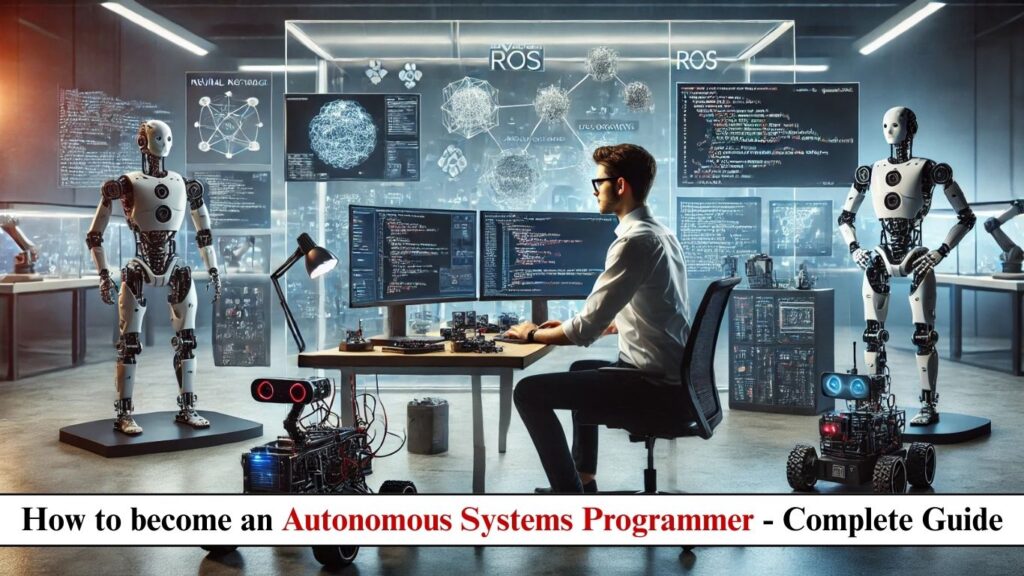
Introduction to Autonomous Systems Programming
The autonomous systems market is projected to reach $1.5 trillion by 2030, revolutionizing industries from transportation to healthcare. Autonomous Systems Programmers develop the intelligence that enables machines to perceive, decide, and act independently—combining robotics, AI, and real-time computing expertise to build the self-operating systems of tomorrow.
This guide covers:
- Evolution of autonomous technology
- Global salary benchmarks
- Core programming responsibilities
- Required technical stack
- Step-by-step career path
- Future industry applications
Whether you’re a software engineer, robotics enthusiast, or AI researcher, this guide provides actionable steps to enter this cutting-edge field.
History of Autonomous Systems
Early Foundations (1940s-1990s)
- 1943: First autonomous torpedoes (WWII)
- 1961: Unimate—first industrial robot
- 1987: Ernst Dickmanns’ autonomous Mercedes van
AI Integration Era (2000-2015)
- 2004: DARPA Grand Challenge spurs self-driving R&D
- 2010: Google’s Waymo begins road testing
- 2014: ROS (Robot Operating System) hits v1.0
Deep Learning Revolution (2016-Present)
- 2016: Boston Dynamics’ Atlas does backflips
- 2020: Tesla “Full Self-Driving” beta release
- 2023: ChatGPT controls robot arms via natural language
- 2024: L4 autonomous drones deliver 1M packages monthly
Autonomous Systems Programmer Salary (2024)
| Experience Level | Average Salary (US) | Industry Variations |
|---|---|---|
| Entry-Level (0-2 yrs) | $95,000-$130,000 | +30% in aerospace |
| Mid-Career (3-5 yrs) | $130,000-$180,000 | +40% in defense |
| Senior (5+ yrs) | $180,000-$300,000 | +50% at FAANG robotics |
Specialty Premiums:
- Sensor fusion: +$25,000
- Edge AI deployment: +$20,000
- Safety-critical systems: +$35,000
Roles & Responsibilities
1. Perception Systems
- Develop LIDAR/radar/camera fusion algorithms
- Implement YOLOv7/Transformer-based object detection
- Optimize SLAM (Simultaneous Localization and Mapping)
2. Decision Architecture
- Code behavior trees for complex scenarios
- Train reinforcement learning policies
- Implement ethical decision frameworks
3. Control Systems
- Program PID controllers for precise actuation
- Develop fail-operational redundancy
- Interface with CAN bus/ROS 2 systems
4. Simulation & Testing
- Build digital twin environments (CARLA, Gazebo)
- Conduct hardware-in-the-loop (HIL) testing
- Automate regression testing pipelines
5. Safety Certification
- Implement ISO 26262/DO-178C compliant code
- Document ASIL-D safety cases
- Audit AI explainability
Required Qualifications
Technical Skills Matrix
| Category | Essential Technologies |
|---|---|
| Languages | C++17, Python, Rust |
| Frameworks | ROS 2, Apollo, Autoware |
| AI/ML | PyTorch, TensorRT, ONNX |
| Sensors | LIDAR (Velodyne), Radar (Continental) |
| Standards | MISRA C++, AUTOSAR Adaptive |
Certification Pathway
- Foundational:
- NVIDIA Jetson AI Specialist
- ROS Professional Certification
- Mid-Career:
- Autonomous Vehicle Engineer (SAE)
- Certified Robotics Software Engineer
- Advanced:
- ISO 26262 Functional Safety
- AWS RoboMaker Certification
How to Get Started: 5-Step Roadmap
Step 1: Build Core Competencies
- Master modern C++ (move semantics, templates)
- Complete Udacity’s Self-Driving Car Engineer Nanodegree
- Practice ROS 2 with TurtleBot3
Step 2: Gain Practical Experience
- Entry-Level Roles:
- Robotics Software Intern (45−45−65/hr)
- AV Test Engineer
- Hands-On Projects:
- Build autonomous RC car with Raspberry Pi
- Compete in RoboMaster AI Challenge
Step 3: Specialize
- High-Demand Niches:
- Agricultural automation
- Last-mile delivery robots
- Space robotics (NASA JPL)
Step 4: Build Portfolio
- Showcase GitHub repos with Kalman filters
- Publish perception algorithm benchmarks
- Document safety-critical design patterns
Step 5: Target Employers
- Industry Leaders:
- Waymo (Perception Team)
- Boston Dynamics (Controls)
- SpaceX (Autonomous Systems)
Future Scope & Trends
1. Emerging Technologies
- 2025: Neuromorphic processors for low-power autonomy
- 2027: Quantum sensors enabling GPS-denied navigation
2. New Applications
- Autonomous ocean farming
- AI-coordinated wildfire fighting drones
- Self-repairing space habitats
3. Market Growth
- $300B autonomous trucking market by 2030
- 500% increase in agricultural robotics
4. Career Innovations
- Robot Ethics Compliance Officers
- Swarm Intelligence Architects
- Autonomy Verification Engineers
Conclusion: Is This Career Right For You?
✅ Ideal Candidate:
- Strong systems programming fundamentals
- Passion for real-time problem solving
- Comfort with safety-critical debugging
🚀 Action Plan:
- Master C++20 and ROS 2
- Build physical robotics projects
- Network at ICRA/IROS conferences
- Specialize in perception/controls/planning
With 90% of industrial robots expected to gain autonomy by 2030, skilled programmers will enjoy decades of career growth.
Want our free autonomous project starter kit? Comment below!
Questions about transitioning from web development? Ask here!













Post Comment